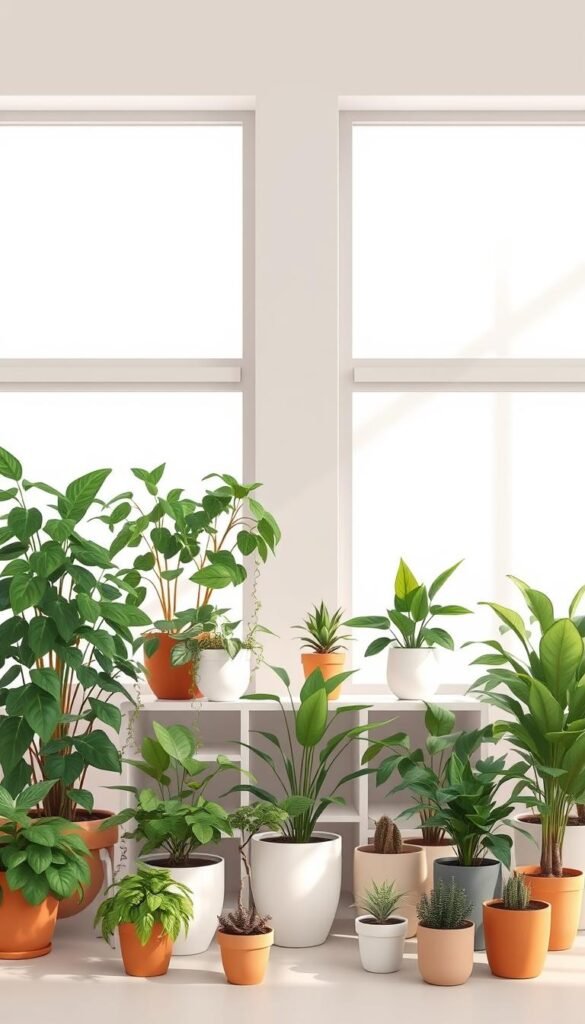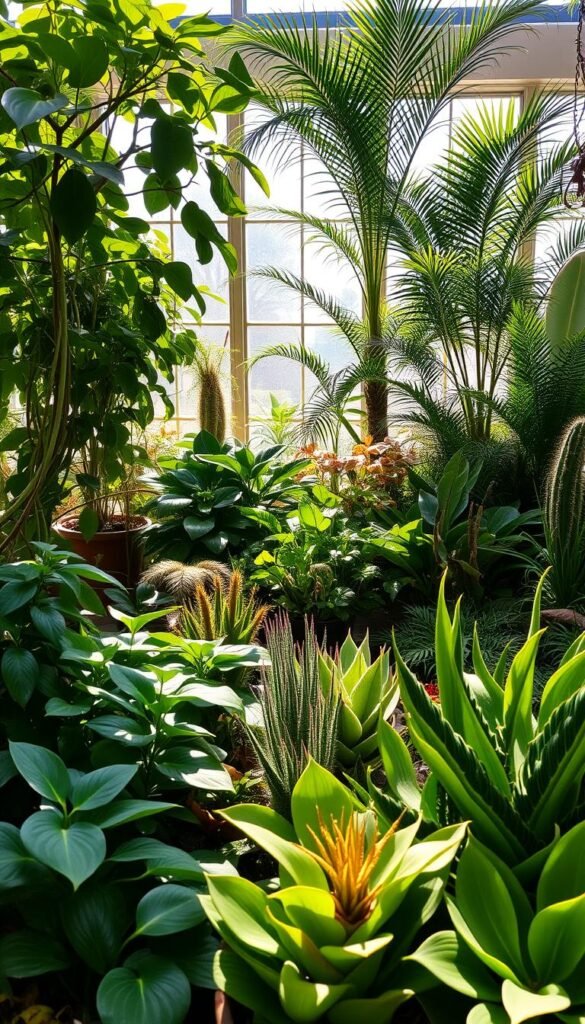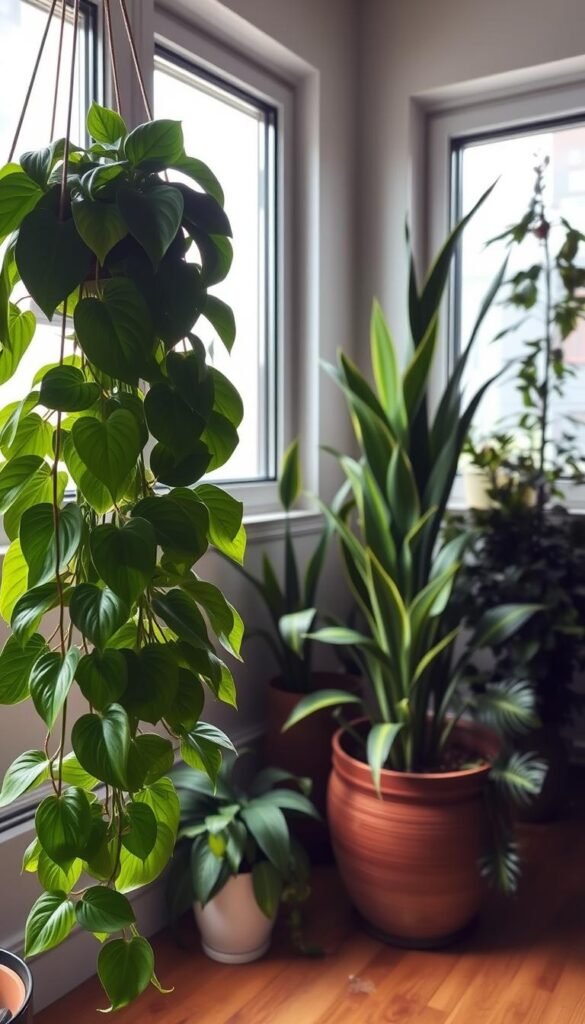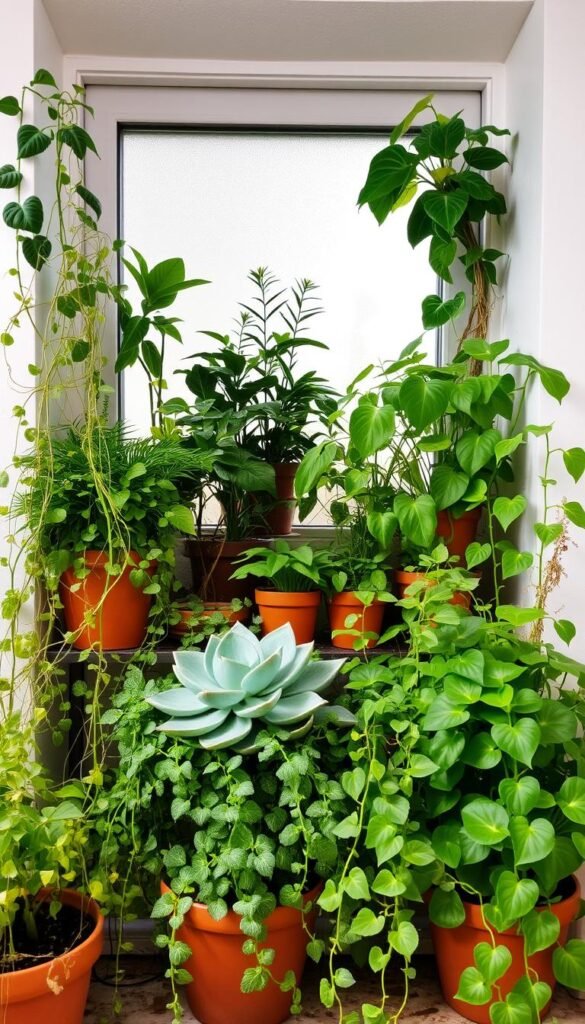Imagine turning those empty spaces near your windows into vibrant displays of greenery. Whether your room gets soft morning rays or afternoon sunshine, the right greenery can thrive with minimal effort. This guide unlocks the secrets to choosing foliage that matches your light conditions perfectly.
Light availability varies across rooms—north-facing areas offer gentle brightness, while south-facing spots deliver intense sunlight. Matching your space’s natural light to a plant’s needs is the golden rule for healthy growth. Forget guesswork: we’ll show you how to assess your environment like a pro.
Some varieties flourish in shaded corners, while others crave sun-drenched sills. Discover resilient options for dimmer spaces and bold choices for brighter zones. You’ll learn to create balanced arrangements that complement your decor and lifestyle.
Ready to craft a living masterpiece? With smart selections and simple care tips, your windows will become dynamic showcases of nature’s beauty. Let’s dive into the leafy details!
Introduction to Indoor Window Gardening

Unlock the potential of your living space by pairing greenery with the natural illumination streaming through your panes. This clever approach lets you craft living art that works with your home’s architecture, not against it. Think of each sill as a stage where foliage becomes the star performer.
Your success starts with recognizing how light behaves in different areas. Morning rays through east-facing glass differ dramatically from the intense afternoon beams in west-facing spots. Matching houseplants to these conditions ensures they’ll thrive rather than just survive.
What makes this style of gardening special? You’re not fighting nature—you’re collaborating with it. Even small spaces become dynamic displays when you choose specimens suited to your environment. Those shadowy corners? Perfect for resilient varieties that flourish in softer brightness.
Best part? You don’t need expert skills to start. Begin by observing how sunlight moves through your rooms. Notice where beams linger and where shadows dominate. This awareness becomes your secret tool for creating arrangements that grow healthier every day.
Understanding Indoor Light Conditions
Light transforms your space into a thriving ecosystem, but only when you decode its patterns. Every corner receives unique illumination—knowing how to work with these differences makes all the difference.
Low Light vs. High Light Explained
Dim areas near north-facing walls or shaded corners aren’t plant deserts. These spots offer gentle light perfect for species that burn easily. Growth slows here, but resilient varieties still flourish with minimal care.
Sun-drenched sills bathed in direct sunlight? That’s prime territory for bold foliage. These high-energy zones fuel rapid growth and vibrant blooms. Just ensure your green companions love basking for 4+ hours daily.
| Light Type | Location | Hours of Light | Best For |
|---|---|---|---|
| Low | North-facing areas | 2-4 | Slow-growing varieties |
| Indirect | East-facing with curtains | 4-6 | Leafy tropicals |
| High | Southwest windows | 6+ | Flowering species |
How Indirect and Filtered Light Affects Growth
Sheer curtains create magic—they soften harsh rays into dappled indirect light that mimics jungle canopies. Most houseplants adore this balanced brightness. It prevents leaf scorch while fueling steady growth.
Filtered conditions through blinds or taller plants create microclimates. Rotate your pots weekly here. This ensures all sides get equal exposure, preventing lopsided growth.
Choosing the Right Indoor Plants for Your Space

Transform your living area into a green oasis by aligning your plant picks with your home’s unique conditions. Think of yourself as a botanical matchmaker—connecting each species to spaces where they’ll flourish naturally.
Light Needs: The Perfect Pairing
Sun lovers and shade seekers have distinct preferences. Check your room’s brightness before adopting leafy companions. South-facing spots suit species craving 6+ hours of direct light, while north-facing nooks work for those preferring soft illumination.
Space Savvy Solutions
Measure your available area before choosing greenery. Compact varieties stay under 1 foot tall—ideal for shelves or desks. Larger specimens can stretch beyond 8 feet, creating living room focal points.
| Size Range | Growth Habit | Placement Tips |
|---|---|---|
| 6-12 inches | Trailing vines | Hanging planters, high shelves |
| 1-4 feet | Upright growth | Floor corners, side tables |
| 5-10+ feet | Tree-like form | Room centers, empty corners |
Consider your schedule when selecting varieties. Busy? Pick drought-tolerant types needing weekly attention. Frequent traveler? Self-watering pots with moisture-loving species simplify care.
Match leaf shapes and colors to your decor. Bold, architectural specimens make statements in modern spaces. Delicate ferns soften minimalist interiors with their feathery textures.
Window Garden Indoor: Best Low-Light and High-Light Plant Selections

Your window spaces become living galleries when filled with foliage suited to their unique brightness levels. Discover species that turn challenging spots into thriving displays – whether your space gets minimal sunshine or all-day rays.
Dim corners needn’t stay bare. Pothos vines cascade beautifully from shelves, while snake plants stand tall like living sculptures. For spaces receiving 2-4 hours of indirect light, consider these resilient options:
| Variety | Light Needs | Mature Size | Key Feature |
|---|---|---|---|
| ZZ Plant | Low | 2-3 ft | Drought-tolerant |
| Peace Lily | Filtered | 1-4 ft | Air-purifying blooms |
| Chinese Evergreen | Shade | 1-2 ft | Colorful foliage |
Sun-drenched sills demand species that soak up rays without wilting. Rubber plants develop glossy leaves under bright conditions, while jade varieties store water in their thick stems. These sun-lovers thrive with 6+ hours of direct light:
“The right plant placement turns windows into dynamic ecosystems – shadows and sunshine both become design tools.”
Mix textures for visual intrigue. Pair spiky aloe with trailing philodendrons, or place a statuesque fiddle-leaf fig beside compact succulents. This variety lets you craft displays that evolve with your space’s changing light patterns.
Spotlight on Top Low-Light Indoor Plants

Dim corners and shaded spaces hold surprising potential for lush greenery. These adaptable specimens thrive where others struggle, turning forgotten nooks into vibrant displays. Their secret? Evolution crafted them to flourish under forest canopies, making them ideal for modern homes with indirect light.
- Snake Plant ‘Black Coral’
Standing tall at 6-20 inches, this architectural marvel stores moisture in sword-like leaves. Water every 2-3 weeks and watch it purify your air. (Note: Keep away from curious pets.) - ZZ Plant
Glossy, waxy foliage shines without polishing. Semi-succulent stems store water, surviving 3-week droughts. Grows 2-3 feet tall, perfect for empty floor spaces. - Peace Lily
White blooms float above dark green leaves from spring through fall. Prefers consistent moisture and reaches up to 6 feet in ideal conditions. - Pothos Varieties
Trailing vines stretch 6-10 feet, adapting to shelves or hanging baskets. Feed monthly and trim to maintain bushy growth. - Blue Star Fern
Frilly T-shaped leaves add texture. Thrives with weekly water and occasional misting for that tropical vibe.
These houseplant heroes prove low-light areas aren’t limitations—they’re opportunities. Whether you’re a frequent traveler or novice plant parent, their resilience ensures success. Start small with one variety, then build your shadow-friendly jungle over time!
Spotlight on Best High-Light Indoor Plants

Sun-drenched windowsills become living canvases when adorned with foliage that thrives under intense brightness. These specimens transform your brightest spaces into dynamic showcases, combining striking forms with sun-loving resilience.
Fiddle-leaf figs reign supreme with their iconic violin-shaped leaves, growing up to 10 feet tall. Place them near east-facing glass where morning rays fuel growth without scorching their foliage. Feed monthly with nitrogen-rich formulas from March through October.
Rubber plants offer architectural drama with glossy, leather-like leaves that stretch toward the sunlight. They adapt well to various conditions once established, reaching similar heights as their fig cousins. Keep soil consistently moist and fertilize biweekly during growth spurts.
| Variety | Height Range | Light Needs |
|---|---|---|
| Alocasia | 2-6 ft | Bright indirect |
| Aloe Vera | 1-2 ft | Direct sun |
Alocasias bring tropical flair with elephant-ear leaves in exotic patterns. These moisture-lovers thrive in humid spots with regular watering during warm months. Pair them with compact aloe plants that prefer snug pots and gritty soil mixtures.
“Rotate sun-worshipping houseplant specimens weekly to ensure balanced growth and prevent leaf burn from intense afternoon rays.”
Seasonal care makes all the difference. Most high-light plants surge in spring and summer, then rest during cooler months. Adjust watering and feeding schedules accordingly to maintain vibrant displays year-round.
Expert Tips on Watering and Soil Care
Keep your greenery thriving with smart care strategies tailored to their needs. Mastering these essentials turns guesswork into confidence, ensuring your specimens stay vibrant year-round.
Watering Frequency and Techniques
Forget rigid schedules—your finger is the best tool. Check soil moisture by pressing it 1-2 inches deep. If it feels dry, water slowly until it drains from the pot’s base. This prevents root rot while quenching thirst.
Drought-tolerant varieties might need drinks every 3 weeks. Tropical types often prefer weekly hydration. Always adjust for seasonal changes—plants drink less in winter.
Soil, Humidity, and Fertilizer Essentials
Well-draining soil is non-negotiable. Mix in perlite or orchid bark to boost airflow. This keeps roots healthy even if you occasionally overwater.
Boost humidity with pebble trays or group plants together. Most varieties thrive at 40-60% moisture levels. Fertilize monthly in spring and summer, then pause during dormancy. A balanced formula works for 90% of houseplants.
Remember: Underwatering is safer than drowning roots. When unsure, wait a day before reaching for your watering can. Consistent checks help you learn each plant’s unique language.






